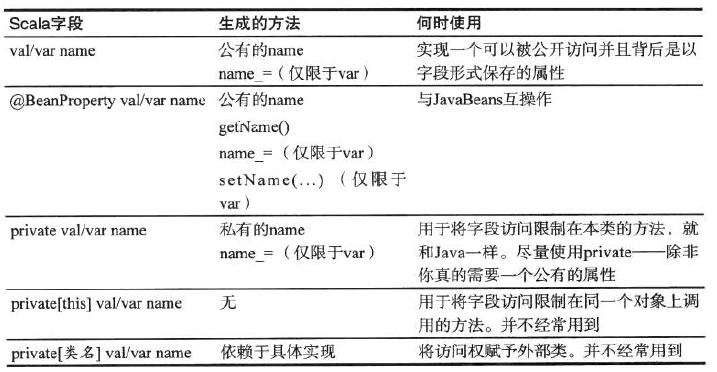一、简单类和无参方法
class Counter{ private var value = 0 def increment(){value += 1} //改变对象状态的方法 使用() def current = value //取值,不改变对象状态的方法, 不使用() } val c = new Counter c.increment() println(c.current) //直接获取值,不带()
结果
1
改值函数使用()
取值函数不使用()
方法默认是共有的
二、带getter和setter属性
// class Persion{ // var age = 0 //非private,可以使用getter和setter
// def current = age //如果age为private,可以自定义一个getter方法 // } class Persion{ private var privateAge = 0 def age = privateAge //getter 方法 age def age_=(newAge:Int) { //setter 方法 age_= _和=不能分开,中间不能有空格, if(newAge>privateAge) privateAge = newAge } } val f = new Persion f.age = 30 f.age = 20 println(f.age)
结果
30

三、对象私有字段
四、Bean属性

import scala.beans.BeanProperty class Persion{ @BeanProperty var age = 0 } val p = new Persion p.setAge(10) println(p.getAge)
结果
10
五、辅助构造器
class Persion{ private var age = 0 private var name = "" def this(name:String){ //辅助构造器 this() //调用主构造器 this.name = name } def this(name:String,age:Int){ //辅助构造器 this(name) //调用辅助构造器 this.age = age } } val p = new Persion //主构造器 val p1 = new Persion("Tom") //辅助构造器 val p2 = new Persion("Tom",10) //辅助构造器
六、主构造器
class Persion(val name:String, val age:Int){ //主构造器的参数直接放置在类名之后 println("Hi") //主构造器会执行类定义中的所有语句 } val p = new Persion("Tom",10)

七、嵌套类


1.
class Counter{ var value = 0L def increment() = value+=1 def current = value } val c = new Counter c.value=Int.MaxValue c.increment() println(c.current)
2.
class BackAccount{ private var value = 0D def deposit(money:Double): Unit ={ value += money } def withdraw(money:Double): Unit ={ value -= money } def current = value } val acc = new BackAccount acc.deposit(100) acc.withdraw(20) println(acc.current)
3.
class Time(val hours:Int,val minutes:Int){ def before(other:Time): Boolean ={ if (hours==other.hours) minutes<other.minutes else hours<other.hours } } val t1 = new Time(2,17) val t2 = new Time(3,18) println(t1.before(t1))
4.
class Time(val hours:Int,val minutes:Int){ def before(other:Time): Boolean ={ if (hours==other.hours) minutes<other.minutes else hours<other.hours } def display(): Unit ={ println(hours+":"+minutes) } def display1(): Unit ={ println(hours*60+minutes) } } val t1 = new Time(2,17) val t2 = new Time(3,18) t1.display() t1.display1() println(t1.before(t1)) println(t1.hours)
5.
import scala.reflect.BeanProperty class Student{ @BeanProperty val name:String ="" @BeanProperty val id:Long = 0L }
D:\>scalac Student.scala D:\>javap -private Student Compiled from "Student.scala" public class Student { private final java.lang.String name; private final long id; public java.lang.String name(); public long id(); public java.lang.String getName(); public long getId(); public Student(); }
6&7. val
class Person(val fullname:String){ val firstName:String = fullname.split(" ")(0) val lastName:String = fullname.split(" ")(1) private var privateAge = 0 def age = privateAge def age_=(newAge:Int): Unit ={ if (newAge<0) privateAge = 0 } } val p = new Person("Fred Smith") println(p.firstName) println(p.lastName)
8.必填参数设置为主构造器
9.
10.
参考《快学Scala》




 浙公网安备 33010602011771号
浙公网安备 33010602011771号